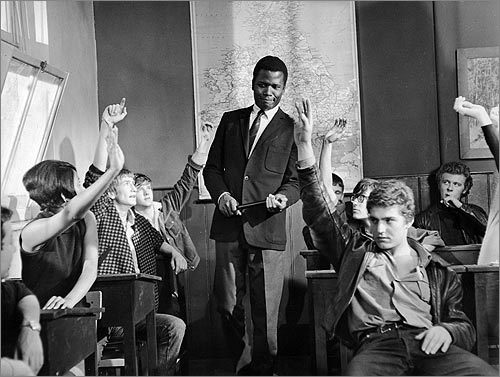The final class of CED0 565 - Leadership and Planning concluded and the course altered my perception of leadership. In the past, I carried a romantic notion of a leader being the strong, rugged individual who could change a system overnight while leading a charge against the old and ushering in a new dawn. A John Wayne or Steve McQueen making things happen while silently drawing-in others in their wake. When John Wayne rides out of town, down the dusty trail, will the people keep working to sustain the good that came about? Not likely as they were never true stakeholders in the change process. I realize now that I held an idealized view of effective leadership and that it takes individuals working, not in a vacuum, but with others to create, attain and sustain a shared community vision.
I now see Teacher Leaders as blurring the lines between administration and teachers for the good of the students. Blurring lines, in this case, is a good thing as it leads to better and more effective communication between administration and the teachers who have to generate results. Teacher Leaders need and should be 
part of the recruiting and hiring process for new staff. They should also be an integral part of any quality improvement initiatives at a school. A better fit for the John Wayne analogy, was his role as Sergeant Stryker in The Sands of Iwo Jima. He trained the troops, oversaw their promotions within the ranks, and would never ask them to do anything he wouldn't do himself. Stryker was tough, fair, and he earned the trust of his mean and they would follow him into battle. Stryker always communicated with the Colonels and Generals above him. In turn, they respected him and his views and the overall outcomes were more effective. Sergeant Stryker dies in battle, but he had trained other soldiers to take his place, and they soldiered on. 
Leadership Potential
A big shift for me was that all of us have inherent leadership potential. It takes all types and kinds of people to lead and affect change. Some leaders are wired for an in-your-face approach while others take time to sow seeds that raise awareness and create a groundswell for change. While the more boisterous and brash individuals may rub people the wrong way, they provide an opportunity to crack open topics and question why things are the way they are. I see that I have been a leader and have even greater leadership potential in the future. Unlocking that potential means utilizing the feedback from my leadership surveys to become a more effective leader.
In society, professionals such as doctors, lawyers and businessmen provide avenues for leadership in their practice and communities. One would hope that good leadership is about raising the social good for as many in our society. Teachers really are leaders in the shaping of young minds so that they may grow-up to be reflective and positive contributors to society. Perhaps this seems like a Utopian view of leadership, but I have seen good things happen when good people apply themselves to seemingly hopeless tasks.
Improving Education from Within
Since I am on a Hollywood theme, one of my favorite movies is To Sir, With Love. The story stars Sidney Poitier as an engineer from the British West Indies who takes a teaching job at a tough, low-income school in London is quite powerful. The older teachers are burnt-out, the younger ones are fearful of the students, and the students see no reason why they even need to be at the school at all. Poitier's character has an epiphany and sets about changing the overall learning environment, or culture, at the school. Poitier leads by example. The change is rough, has its low points, but the school and students are better for it in the end.
I have always been moved by To Sir, With Love. In the end, he finds his true calling as a teacher to students and as an exemplar to his peers and administration. I can think of no finer depiction of a Teacher Leader who can and does change the system from within. Yes, I believe that all of us can change the system or organization that employs us. It takes effort, deliberate action, making time for others and raising awareness. And, while we walk the walk, show patience and understanding for those that are slow to come around. In the end, they rise and join with the others.









